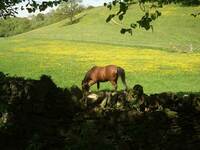- England
- Scotland
- France
- Holland
- Germany
- Italy
- Spain
- Portugal
- USA
- China
- Japan
- India
- Iran
- Advice
- Gardens
- England
- Scotland
- France
- Holland
- Germany
- Italy
- Spain
- Portugal
- USA
- China
- Japan
- India
- Iran
- Advice
- Garden Tours
Book: Landscape Planning and Environmental Impact Design: from EIA to EID
Chapter: Chapter 7 Agriculture, farming and countryside policy
The supply of public goods from agricultural land can be encouraged by zoning regulations, tax incentives, land re-organisation, acquisition of easements and land purchase. The developed industrial countries, including the USA, Europe and Japan have spent large amounts of money on agricultural support, partly to buy votes but also to secure a strategic capacity for food production. Some of the money has remained with farmers. Most of it has gone to the manufacturers of fertilisers, herbicides and farm machinery. All have become so accustomed to feather-bedding with government funds that they can conceive no other way. In 1957, the New Statesman's 'This England' column reported that: Sir James Turner gave an assurance that the Farmers' Union are not in principle opposed to the complex operation of turning over from controls to a free economy, but it will take some time to work out the best way of obtaining guaranteed markets and assured prices under the new system (Hilton 1957: 59). Farmers worked out a brilliant solution to the problem. In Europe it is known as the Common Agricultural Policy. But a time for change is upon agriculture once more. Underlying the discussion of this chapter is the belief that public funds spent on agriculture should be used to purchase specified public goods, according to the geographical nature of the land. Here are three examples: Productive agricultural lowlands, remote from towns. Public funds can be used to maintain a strategic capacity for food production. Arable land should be fallowed and maintained by low intensity grazing. Field drainage systems should be maintained. Farm machinery and farm workers may need to be kept in training, as an 'agricultural militia'. Scenic and recreational areas, remote from towns. Public funds can be used for scenic protection and to acquire recreational access. Money can also be used to support the production of high quality foods by non-industrialised methods. The consumption of such products should be part of the recreational experience. Urban fringe land. Whatever the existing land quality, there is likely to be a future demand for recreation, scenery, water conservation, wild food and firewood. In order to make these goods available, public money may need to be spent on car parks, footpaths, cycle ways, bridleways, lakes and forests - with 'forest' used in the traditional sense, to mean an open area, like Luneburg Heath or the New Forest, with some woods, heath, scrub, grazing and open access for the local community and visitors. The public goods described in these examples can be obtained through a variety of measures: Payments can be made when there are specific tasks to be carried out, such as the construction of paths and bridges, or repairs to farm walls [Fig 7.21] and historic features. Zoning regulations can be used to encourage one type of development or protect against another type of development. Zoning policies could be used on the urban fringe, to permit low density residential or industrial development in exchange for the establishment of new forests. Tax incentives can be used to encourage land uses, like tree planting, which produce benefits in the medium or long term. Acquisition of easements is a good means of establishing new footpaths and cycleways. It is best if the purchase is made on the open market but it may be necessary to use legal powers, as has always been done for roads, railways and other public utilities. Payment could be made at market prices + 25%. Land re-organisation. The greatest opportunities for the creation of public goods arise with legislation for land reï¾organisation. As in Holland, land can be taken into public ownership, replanned, and returned to the private sector. This is an appropriate policy for the urban fringe, where development is taking place and agriculture is declining. Land purchase by public bodies can be justified if it satisfies a public objective. Waterside land can contribute to nature conservation and recreation objectives. Land at the margin of agricultural profitability will often have a high nature conservation value. Scenic land may attract such large numbers of visitors that agriculture will tend to be unprofitable. New woods tend to not produce economic benefits in the lifetime of the individuals who carry out the planting. Land which has increased in value because of a public investment can pass through public ownership, to ensure that the rewards from the public expenditure accrue to the public. This should happen, for example, around a new railway station at the urban fringe. Europe, as noted above, spent ,95bn on agricultural support in 1995. If 30% of this money were invested in environmental public goods, the public would reap a stupendous harvest of benefits.
